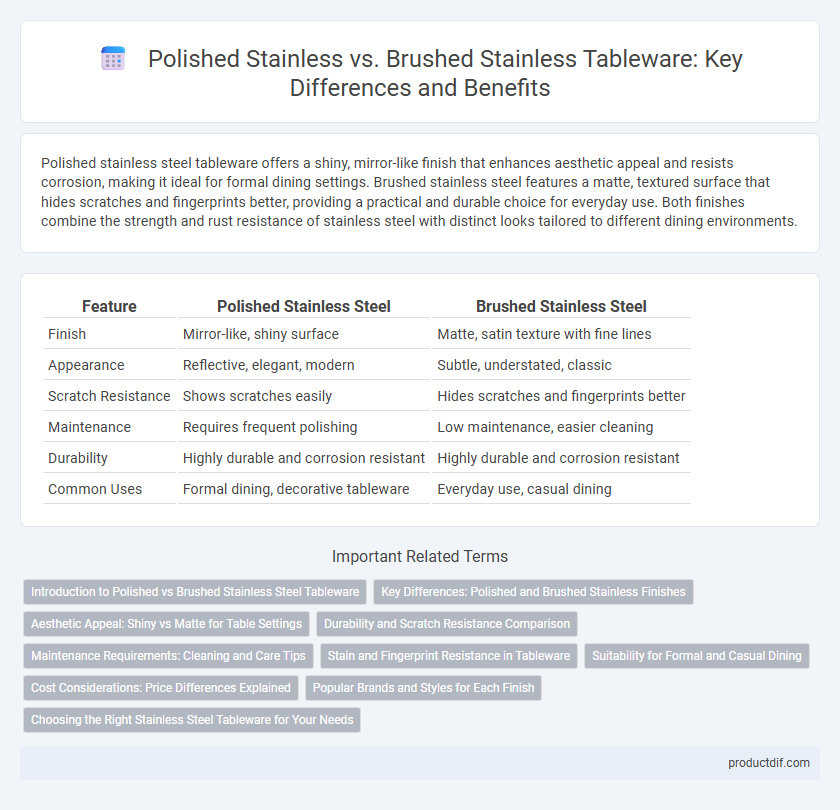Polished stainless steel tableware offers a shiny, mirror-like finish that enhances aesthetic appeal and resists corrosion, making it ideal for formal dining settings. Brushed stainless steel features a matte, textured surface that hides scratches and fingerprints better, providing a practical and durable choice for everyday use. Both finishes combine the strength and rust resistance of stainless steel with distinct looks tailored to different dining environments.
Table of Comparison
| Feature | Polished Stainless Steel | Brushed Stainless Steel |
|---|---|---|
| Finish | Mirror-like, shiny surface | Matte, satin texture with fine lines |
| Appearance | Reflective, elegant, modern | Subtle, understated, classic |
| Scratch Resistance | Shows scratches easily | Hides scratches and fingerprints better |
| Maintenance | Requires frequent polishing | Low maintenance, easier cleaning |
| Durability | Highly durable and corrosion resistant | Highly durable and corrosion resistant |
| Common Uses | Formal dining, decorative tableware | Everyday use, casual dining |
Introduction to Polished vs Brushed Stainless Steel Tableware
Polished stainless steel tableware features a smooth, reflective surface that enhances elegance and highlights intricate design details, making it ideal for formal dining settings. Brushed stainless steel tableware displays a matte finish with fine parallel lines, providing a subtle texture that masks fingerprints and scratches, perfect for everyday use. Both finishes offer durable, corrosion-resistant qualities essential for long-lasting, high-quality tableware.
Key Differences: Polished and Brushed Stainless Finishes
Polished stainless steel tableware features a smooth, reflective surface that enhances its aesthetic appeal and is easier to clean due to its non-porous finish. Brushed stainless steel tableware displays a matte, textured surface with fine lines, providing better scratch resistance and a more understated, modern look. The choice between polished and brushed finishes impacts durability, maintenance, and visual style in kitchen and dining applications.
Aesthetic Appeal: Shiny vs Matte for Table Settings
Polished stainless steel offers a shiny, reflective surface that enhances table settings with a sleek, modern aesthetic, making it ideal for formal occasions. Brushed stainless steel features a matte finish with a subtle texture, providing a more understated, contemporary look that resists fingerprints and scratches. Both finishes contribute distinct visual appeal, allowing hosts to choose between bold shine or muted elegance for their tableware.
Durability and Scratch Resistance Comparison
Polished stainless steel tableware offers a sleek, mirror-like finish that enhances aesthetic appeal but is more prone to visible scratches and requires frequent maintenance to retain its shine. Brushed stainless steel features a matte texture created by fine sanding, which effectively conceals minor scratches and fingerprints, making it more durable for everyday use. Both finishes maintain high corrosion resistance and structural integrity, but brushed stainless steel provides superior scratch resistance, ideal for long-term durability in busy dining settings.
Maintenance Requirements: Cleaning and Care Tips
Polished stainless steel tableware requires regular cleaning with mild detergent and soft cloth to maintain its reflective finish and prevent fingerprints or smudges. Brushed stainless steel demands less frequent polishing but benefits from wiping with a damp microfiber cloth to preserve its matte texture and resist showing scratches. Both finishes avoid abrasive cleaners and steel wool to extend the lifespan and maintain the aesthetic appeal of the tableware.
Stain and Fingerprint Resistance in Tableware
Polished stainless steel tableware exhibits a sleek, reflective surface that tends to show fingerprints and smudges more prominently, requiring frequent cleaning to maintain its shine. Brushed stainless steel features a matte finish with fine lines that effectively mask fingerprints and stains, providing better resistance to everyday marks and reducing visible wear. Choosing brushed stainless steel enhances the durability and aesthetic appeal of tableware, making it ideal for high-use settings where maintaining a clean appearance is essential.
Suitability for Formal and Casual Dining
Polished stainless steel offers a shiny, reflective finish that enhances the elegance of formal dining settings, making it ideal for special occasions and upscale table presentations. Brushed stainless steel features a matte, textured surface that resists fingerprints and scratches, making it more suitable for casual dining and everyday use. The choice between polished and brushed stainless steel tableware depends on balancing aesthetic appeal and practicality according to the dining context.
Cost Considerations: Price Differences Explained
Polished stainless steel tableware typically costs more due to its labor-intensive finishing process, which results in a smooth and reflective surface requiring additional polishing steps. Brushed stainless steel, with its matte texture created by sanding with a fine-bristle brush, involves less processing time and thus offers a more budget-friendly option. The price difference often reflects the manufacturing complexity and the desired aesthetic, making polished options pricier for upscale dining settings.
Popular Brands and Styles for Each Finish
Popular brands like Zwilling and All-Clad offer polished stainless steel tableware, prized for its reflective, mirror-like finish that complements formal dining settings. Brushed stainless steel, favored by brands such as Cuisinart and Calphalon, presents a matte, textured look that suits modern and casual tableware styles. Each finish caters to distinct aesthetic preferences, with polished stainless enhancing elegance and brushed stainless emphasizing durability and understated sophistication.
Choosing the Right Stainless Steel Tableware for Your Needs
Polished stainless steel tableware offers a shiny, reflective surface that enhances elegance and is highly resistant to stains, making it ideal for formal dining settings. Brushed stainless steel features a matte finish with subtle texture, providing better scratch concealment and a modern, understated aesthetic suited for everyday use. Selecting between polished and brushed stainless steel depends on balancing visual appeal with practicality, ensuring the tableware matches your dining style and maintenance preferences.
Polished stainless vs Brushed stainless Infographic

 productdif.com
productdif.com